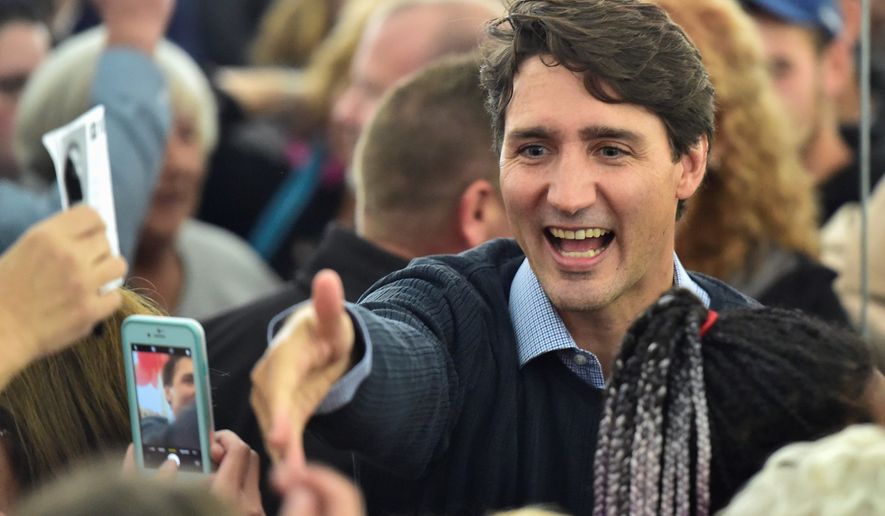The U.S. and Canada have a path to a new NAFTA deal when trade talks resume Wednesday, said economists and diplomats, but the negotiators will have to get beyond President Trump’s tough rhetoric.
The talks resume after negotiators failed to strike a deal before Mr. Trump’s Friday deadline for Canada to join a tentative U.S.-Mexico pact that would replace the three-way North American Free Trade Agreement.
Without Canada on board, the U.S.-Mexico deal faces a steeper climb and big pitfalls in Congress. But Mr. Trump insists he’s ready to jettison Canada, which he accuses of “decades of abuse” on trade.
He notified Congress that he was moving ahead with a U.S.-Mexico deal to replace NAFTA, possibly without Canada. And if Canada is out, Mr. Trump said he would hit them with a 25 percent tariff on cars.
“All of Trump’s blustering, I believe, is irrelevant to everything that is going on. It is just talk, cheap talk,” said University of Toronto economist Daniel Trefler, who helped launch the recent trade deal between Canada and the European Union.
He said there are potential openings to resolve the major sticking points.
Michael Camunez, who helped lead effort to pass and implement the original NAFTA as U.S. ambassador to Mexico under President Clinton, said Mr. Trump had backed Prime Minister Justin Trudeau into a corner. To get a deal, he said, the U.S. has do give Mr. Trudeau a way out without looking beaten.
“Trump is making the situation worse at the moment. His tweets, his taunts, his bullying is really taken on quite an unusual personal and negative tone,” Mr. Camunez said. “He is really trying to force the Canadians but — I don’t know, I’m not terribly optimistic the Canadians are going to take the bait.”
Replacing NAFTA is a top priority for Mr. Trump, who calls it “the worst deal ever made” and blames the 24-year-old deal for killing U.S. manufacturing.
A major sticking point in the renegotiation with Canada is Mr. Trump’s demand for an end to Ottawa’s high tariffs on dairy products, which can run nearly 300 percent.
A bigger sticking point is Canada’s demand for a continuation of the dispute settlement mechanism in NAFTA’s Chapter 19. The U.S.-Mexico deal nixed Chapter 19 and Canada wants it back to challenge U.S. tariffs on lumber, newsprint, steel and aluminum.
The dairy tariffs are a tricky one for Mr. Trudeau because politically powerful Quebec produces about half of Canada’s dairy products and wants the protectionist policy.
Mr. Trefler said that Mr. Trump should be able to extract a symbolic win while allowing a continuation of most of the dairy tariffs that only hit a small amount of U.S. imports.
“He needs something. Can Canada give Trump something without too much frustrating Quebec? The answer I believe is yes. We did it with Europe. They can problem do it with the U.S.,” he said. “They can give him exactly the type of thing Trump loves and the [World Trade Organization] hates — a quota. Give them say 4 percent of the Canada market.”
For the Chapter 19 question, Mr. Camunez said a possible answer would be to eliminate it but to grandfather in some industries for continued use of the dispute process.
“The Canadians have very strongly held red lines and concerns and national interests, and my strong sense is they are not going to just play ball because Donald Trump says so,” he said.
Mr. Trefler said the negotiators needed a repeat of the 1988 U.S.-Canada free trade deal, a precursor to 1994’s NAFTA, that came down to the wire because the two sides couldn’t decide on a dispute resolution mechanism.
“It was dead in the water because issues related to Chapter 19,” said Mr. Trefler. “It was the very last topic. It was the most contentious topic and we had a quid pro quo. Canada got Chapter 19. The United States got access to Canadian oil.”
“We will find another compromise that gives Canada a Chapter 19 and give the United States something big that they want from Canada,” he said.
• S.A. Miller can be reached at smiller@washingtontimes.com.




Please read our comment policy before commenting.